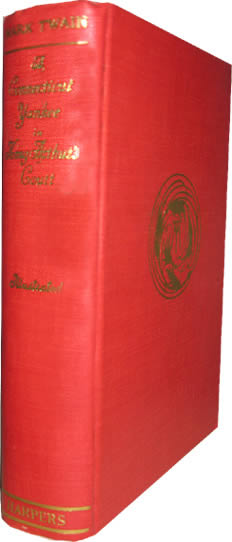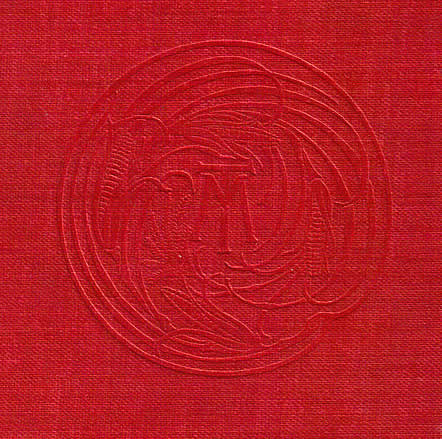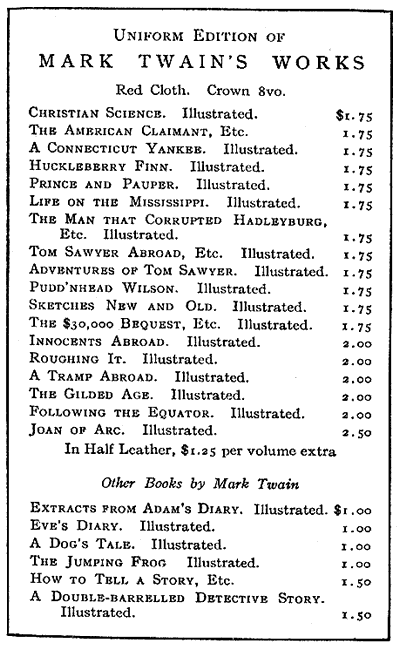SPECIAL FEATURE
by Barbara Schmidt
A History of and Guide to
UNIFORM EDITIONS OF MARK TWAIN'S WORKS
Harper's New and Uniform Library Editions
Red Cloth and Gold Cornstalks
Harper and Brothers began issuing Mark Twain's books in uniform binding in 1896 beginning with five books they acquired in their contract with Olivia Clemens. As Harper acquired rights to additional Mark Twain books, they added to the list of titles bound in red cloth with the gold cornstalk monogram. The official name Harper assigned to this set ranged from "New Library Edition" to "New and Uniform Library Edition" to "Uniform Edition." An advertisement in the book review section of The New York Times on April 10, 1897 referred to the books as "New Library Editions.

Harper advertisement
from the book review section of The New York Times, April 10, 1897.
 Introduced in 1896, Harper's cornstalk bindings featured a gold cornstalk MT monogram stamping on the front cover. |
 Titles were stamped in gold on the spine. |
The 1896 Harper volumes featured uniform bindings of red cloth and circular gold corn husks around an MT monogram on the front. Early bindings also featured a blind stamped impression of the cornstalk on the back cover. The back cover impression was eliminated on later printings.

Early printings
featured the blind stamped cornstalk monogram on the back cover.
The volumes were not issued as sets and included no volume numbers. Illustrations that had appeared in the lavishly illustrated first editions were often eliminated. Frequently illustrations that were once imbedded in text in the first editions were reprinted as full-page plates. By 1907 Harper had issued eighteen volumes in this series and advertised them in both cloth and half leather for an additional $1.25 extra. No samples of the half leather volumes have been located.

Ad from the
back of the title page for an edition of Tom Sawyer Abroad printed
after 1907.
By 1922 any specific edition name for the Harper red cloth uniform series had been dropped from the title pages. Harper would eventually publish at least 26 titles in the red cornstalk bindings. The vast majority of the cornstalk uniform editions found today are later printings. Book buyers and sellers have often mistaken the older copyright dates as the actual dates of printing. The later reprintings often feature fewer full-page illustrations than earlier printings of the same title, lack the cornstalk impression on the back cover and are printed on less expensive paper. Sometimes ads for other books in the series offer clues to the actual date of printing.
Dust Jackets Included
|
The Harper cornstalk series were issued in dust jackets. The jackets on the first few volumes of the Uniform Edition issued in 1896 were buff paper and were blank except for lettering on the spine. The end flaps were short and the jacket likely served as a protector during shipping rather than a collectible. Most jackets were discarded once a book reached its final destination and was proudly displayed on the home library shelf in a row of red and gold. Few of these jackets have survived. According to rare book dealer Kevin Mac Donnell, in 1900 The Man that Corrupted Hadleyburg was the first jacket in the series that featured printing on the front and back panels and flaps. The jacket for that book featured ads on the rear panel for books by John Kendrick Bangs. The dust jacket flaps for books after 1902 had a boxed ad for a book on one flap and a boxed "how to open a book" instruction on the other flap; this became the usual pattern with very little variation. By the time The $30,000 Bequest was added to the series in 1906 the front panel included a boxed ad for the Uniform Edition of Mark Twain's works and the flaps were longer. When Christian Science was added to the series in 1907, the jackets featured titles on the spine and front panel. The rear panel contained a Uniform Edition boxed ad for Mark Twain's works. |
 The Harper cornstalk editions were first issued in dust jackets featuring lettering on the spine only. Few samples have survived. This photo of the 1896 edition of Tom Sawyer Abroad is from the Kevin Mac Donnell collection. |
The boxed ads for the Uniform Edition on the jackets of Twain's Harper books are useful for dating the jackets. The earliest state of a given jacket generally has ads that list the titles in the Uniform Edition ending with the latest book The boxed ads usually included both his Uniform Edition titles in one list and his non-Uniform Edition titles in a second list, and these boxed ads appear on the rear dust jacket panels of nearly all of Mark Twain's books into the 1920s.
Volumes in Harper's Red Cloth Gold Cornstalk Bindings

